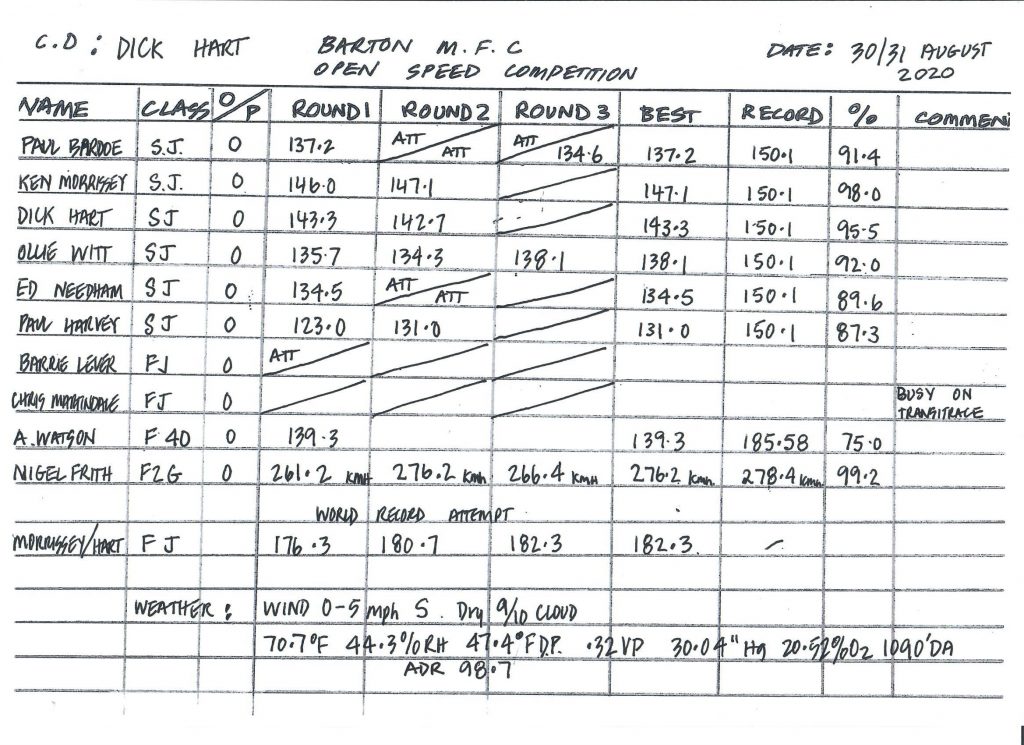Many people have wanted to fly in control line speed but have been put off by a number of reasons, these could be a lack of equipment availability, not sure of their flying ability, worried of making a fool of themselves and the list goes.
One of the major aims of this site is to debunk these fears and myths and get newcomers heading in the right direction with an amount of guidance that is suitable for them. So firstly lets look at flying skills.
First lets look at how open speed meetings are scored.
Scoring
Records exist for all UK Open Speed control line classes, for example Sport Jet is held at 150.1 mph, in the few cases where there have been rule changes and new records have not been set in competition then a nominal place holder record is created, however there are only a few cases of this.
To enable all types of models to compete against one another, what happens is that your score is represented as a % of the class record for the type of model that you are flying, so if you fly a Sport Jet at 145mph your score is 96.60% as that is what 145 mph represents of 150.1 mph. A fellow competitor maybe flying a 0.40 model which achieves 190 mph and the UK record for that class is 200.09 mph so his score 94.95%, the 145 mph Sport Jet therefore beats the 190 mph 0.40 model as the Sport Jet has performed better as a percentage of the record.
Looking at the following score sheet, we can see that the winner is Nigel Frith with 99.2% flying an electric F2G model, 2nd was Ken Morrisey with 98.0% flying a Sport Jet and 3rd was Dick Hart with 95.5% and there is how the scoring for open speed works, very simple and clean.
The timing is carried out by an automatic timing system called Transitrace and this works really well.

Flying
What level of flying ability is required to fly control line speed? Competitors range from super ace professional drone pilots right through to people who cannot fly a control line model either due to age/disability or being a complete newcomer. everyone is accommodated within control line speed competitions, it is very inclusive.
If a competitor is not confident to fly their model for whatever reason then they can nominate a proxy pilot of their choice, this pilot then flies the model for the competitor and the proxy pilot does not feature in the results rather the entering competitor does, the only stipulation is that the entering competitor has to be involved in the preparation and starting of the model. Proxy piloting is allowed in all classes except the International F2A and F2G. So right away we can see that just about anyone can participate in control line speed which is great.
So now lets look at what level of ability is required if a newcomer is to fly their own model? Well a lot will depend on which class of model they choose to fly. Barton Club Speed models can be just about any 2 line control line model with a 1.5cc engine, most people fly a redundant mini-goodyear model and these are very strong and not demanding on the pilot. When I started flying control line, I learned on a KK Phantom Mite and then progressed to a Deerfly mini-goodyear model, so at that stage I would have been ready to fly in Barton Club Speed.
Most new comers to control line speed in the last 5 years, have been Sport Jet competitors, these models fly between 135 and 150 mph, they are very good flyers and have a heap of line tension which is quite reassuring, to fly Sport Jet for the first time a pilot really needs to be confident on a model that flies in the 90 to 100 mph range, a Texas Quickie Rat racer is good for providing this stepping stone.
Models
TBC.
